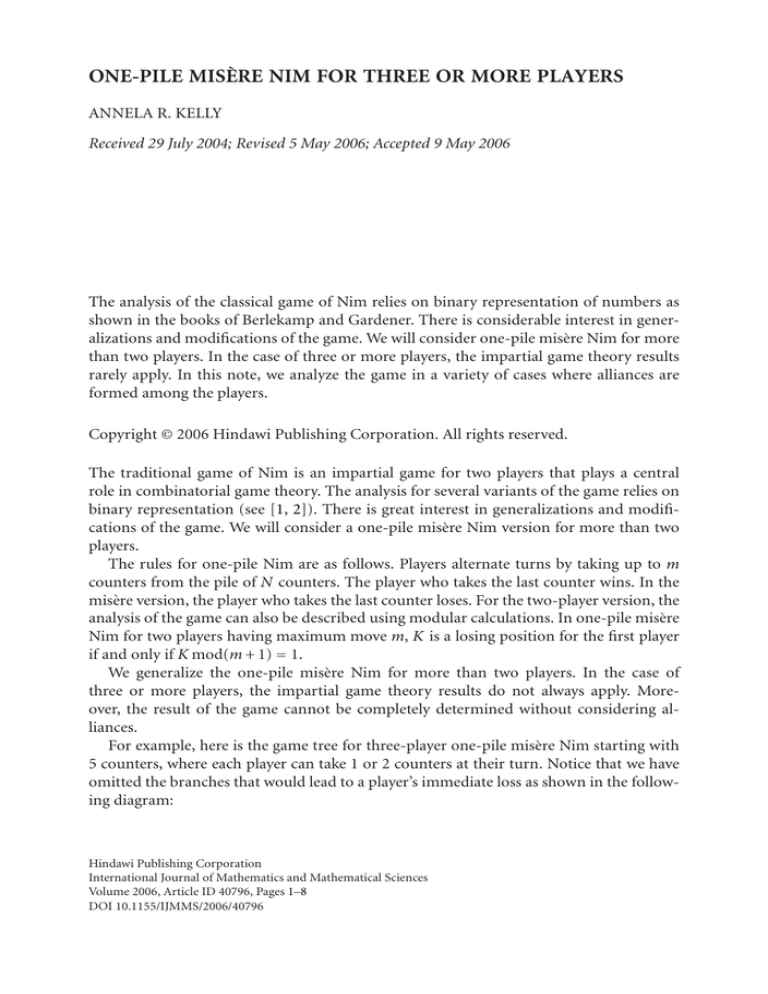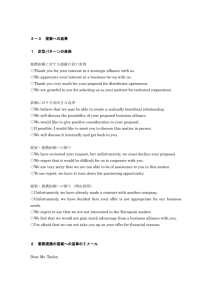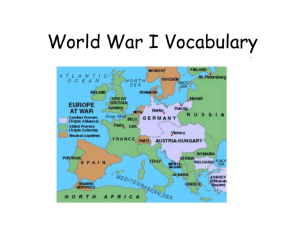
ONE-PILE MISÈRE NIM FOR THREE OR MORE PLAYERS
ANNELA R. KELLY
Received 29 July 2004; Revised 5 May 2006; Accepted 9 May 2006
The analysis of the classical game of Nim relies on binary representation of numbers as
shown in the books of Berlekamp and Gardener. There is considerable interest in generalizations and modifications of the game. We will consider one-pile misère Nim for more
than two players. In the case of three or more players, the impartial game theory results
rarely apply. In this note, we analyze the game in a variety of cases where alliances are
formed among the players.
Copyright © 2006 Hindawi Publishing Corporation. All rights reserved.
The traditional game of Nim is an impartial game for two players that plays a central
role in combinatorial game theory. The analysis for several variants of the game relies on
binary representation (see [1, 2]). There is great interest in generalizations and modifications of the game. We will consider a one-pile misère Nim version for more than two
players.
The rules for one-pile Nim are as follows. Players alternate turns by taking up to m
counters from the pile of N counters. The player who takes the last counter wins. In the
misère version, the player who takes the last counter loses. For the two-player version, the
analysis of the game can also be described using modular calculations. In one-pile misère
Nim for two players having maximum move m, K is a losing position for the first player
if and only if K mod(m + 1) = 1.
We generalize the one-pile misère Nim for more than two players. In the case of
three or more players, the impartial game theory results do not always apply. Moreover, the result of the game cannot be completely determined without considering alliances.
For example, here is the game tree for three-player one-pile misère Nim starting with
5 counters, where each player can take 1 or 2 counters at their turn. Notice that we have
omitted the branches that would lead to a player’s immediate loss as shown in the following diagram:
Hindawi Publishing Corporation
International Journal of Mathematics and Mathematical Sciences
Volume 2006, Article ID 40796, Pages 1–8
DOI 10.1155/IJMMS/2006/40796
2
One-pile misère Nim for three or more players
5
Player 1 leaves:
3
4
Player 2 leaves:
3
Player 3 leaves:
2
Player 1 leaves:
1
1
2
2
1
1
1
In this game, player 2 is safe if he plays wisely and he also determines who will lose the
game. Hence player 1 and player 3 should each attempt to persuade player 2 to cooperate
with them. This leads us to considering the game with known alliances. The game of
misère Nim with alliances resembles the early phases of the “Survivor” game.
Definition 1. Consider the game for three or more players that follows the rules of misère
Nim for each player. Suppose that the players form two alliances and that each player is
in exactly one alliance. Also assume that each player will support his alliance’s interests.
This game will be called Survivor Nim.
We first consider several games with an even number of players.
Proposition 2. Consider Survivor Nim for 2n players, where the even-numbered players
form one alliance and the odd-numbered players form another alliance. Suppose each player
is allowed to remove 1,...,m counters on his turn. This game is isomorphic to the two-player
one-pile misère Nim, where each player removes 1,...,m counters at his turn.
Proof. Suppose P1 ,P3 ,P5 ,...,P2n−1 form one alliance while P2 ,P4 ,P6 ,...,P2n form another
alliance. By applying the calculations for determining the advantage in the two-player
game, each player in the alliance with an advantage will be able to make a move to
maintain the advantage for his alliance. Hence we can look at this game as a two-player
game.
In the games, where the alliances formed involve two or more consecutive players, the
end of the game differs from genuine two-player misère Nim. In misère Nim, the player
who makes the last possible move loses. In Survivor Nim, if there remain fewer counters
than an alliance’s combined minimum move, the player or players in that alliance must
take these (if there are more counters than each player’s minimum move) and lose the
game.
For example, consider a Survivor Nim game with 7 players, where each player removes
1 or 2 counters at their turn. Let the first four players form alliance 1 and the last three
players form alliance 2. Suppose that at some point in the game, alliance 2 reduced the
Annela R. Kelly 3
pile to three counters with their turns. In Survivor Nim, alliance 1 removes 3 counters and
loses. In misère Nim, if we consider alliance 1 as a single player, he cannot move, since
he needs at least 4 counters, hence alliance 2 loses the game by making the last possible
move. Because we will have several cases where the only discrepancies in comparing two
games happen for a “few small values,” we make the following definition. In our note, we
follow the notation introduced in [1].
Definition 3. Let G1 be a misère Nim game with K1 counters and let G2 be a Survivor
Nim game with K2 counters. Let j be a positive integer. Suppose the positive and zero
positions in the misère Nim game with K1 counters are the same as the positive and zero
positions in the Survivor Nim game with K2 − j counters. Then say that the game G2 is
reducible to the game G1 .
Proposition 4. Consider the Survivor Nim for 2n players, where each player removes
1,...,m counters on his turn. If the first n players form one alliance and the second n players form another alliance, then the game is reducible to two-player misère Nim, where each
player can take n,...,mn counters.
Proof. On his turn, each player in the winning alliance will use the strategy to support
his alliance. Hence, we can look at this game as a two-player game, where we combine all
the possible moves for players in a given alliance. Hence, this game is reducible to a twoplayer game, where each player removes n,...,nm counters. Note that the zero positions
for this Survivor game are shifted by n from the zero positions of misère Nim game with
the same number of counters.
Corollary 5. The zero positions (those such that the player who starts must lose) for the
Survivor Nim game in Proposition 4 satisfy the condition N mod((m + 1)n) ∈ {0,...,n}.
Proof. Using the Mex rule [1, page 56] for this game, we can calculate the Nim values Ᏻ
for this game with N counters by Ᏻ(N) =mex(Ᏻ(N − n),Ᏻ(N − n − 1),...,Ᏻ(N − mn)).
The Nim sequence for this game is given in the table below:
N 1 2 3 · · · n − 1 n n + 1 · · · 2n 2n + 1 · · ·
0 0 1 1 2 G(N) 0 0 0 3n − 1 3n · · · (m + 1)n − 1 (m + 1)n ....
2 2 m
0
(1)
Note that this sequence is periodic and the zeros occur when N mod((m + 1)n) ∈
{0,...,n}.
Combinations of unequal alliances will require a more detailed analysis. If we consider
an odd number of players, we need to develop new methods of proof as these games do
not follow the classical combinatorial game theory.
For example, consider a Survivor Nim game with 7 players, where each player removes
1 or 2 counters on his turn. Suppose the first four players form alliance 1, and the last
three players form alliance 2. Notice that if alliance 2 reduced the pile to 1, 2, 3, or 4
counters on his turn, then alliance 1 loses. On the other hand, if alliance 1 reduced the
4
One-pile misère Nim for three or more players
pile to 1, 2, or 3 counters on their turn, then alliance 2 loses. If alliance 1 reduces the pile
to 4 (or 5, 6, 7, 8, 9, and 10) counters at his turn, then alliance 1 loses. Similarly, if alliance
2 reduces the pile to 5, 6, 7, 8, 9, 10, or 11 counters at his turn, then alliance 2 loses. We
see from here that it is a Partizan game, that is, players have different options on a given
position. The following definition introduces useful terminology we will be using for the
rest of the note.
Definition 6. A collection of consecutive losing positions for one alliance is called a round.
Definition 7. Suppose one has a game, where k players take turns. The set of turns, where
one starts with player one, and all k players have their turn, is called a cycle.
Theorem 8. Consider the Survivor Nim for 2n + 1 players, where each player removes 1
or 2 counters on his turn. If the first n + 1 players form one alliance and the last n players
form another alliance, then the game is reducible to a two-player misère game, where the
first player takes n + 1,...,2(n + 1) counters and the second player takes n,...,2n counters.
Moreover, the largest game that the first alliance loses is with 3n2 + 2n + 1 counters.
Proof. Suppose the first n + 1 players form alliance 1 and the last n players form alliance 2.
Obviously, alliance 1 loses the games with up to n + 1 counters. Denote the largest number
of counters that alliance 1 loses in his first round of losses by N11 = n + 1. Alliance 2 loses
a round of games starting with N = n + 2 up through N − 2(n + 1) = n counters, that
is, n + 2 ≤ N ≤ 3n + 2. This follows because alliance 1 can take up to 2(n + 1) counters
at his turn and leaves at most n. Let us call N12 = 3n + 2 the largest number of counters
for which alliance 2 loses in his first round of losses. Similarly, alliance 1 loses the games
when N = 3n + 3 until N − (n + 1) − 2n = n + 1, so 3n + 3 ≤ N ≤ 4n + 2. This is because
no matter what alliance 1 does, alliance 2 can always leave n + 1 counters or less after
his turn. Let us call it the second round of losing positions for alliance 1 and denote
the largest number by N21 . Moreover, alliance 2 loses for the next positions when N =
4n + 3 up to N − 2(n + 1) − n = 3n + 2 implying that 4n + 3 ≤ N ≤ 6n + 4. Let us call it the
second round for alliance 2 and denote the largest number by N22 . To summarize these
observations, we have
N11 − (n + 1) = 0,
N12 − 2(n + 1) − n = n,
N21 − (n + 1) − 2n = N11 ,
(2)
N22 − 2(n + 1) − n = N12 .
We use induction to prove that
N j1 = j(n + 1) + ( j − 1)2n,
N j2 = j2(n + 1) + jn,
0 < j ≤ n + 1,
0 < j ≤ n.
(3)
To verify the induction step, note that if N j1 = j(n + 1) + ( j − 1)2n and N j2 = 2 j(n +
1) + jn, j > 0, then in the games with N j2 + 1,...,N( j+1)1 counters, no matter how many
counters alliance 1 takes, there will be still N j1 or less counters left after alliance 2 turn.
Hence, the largest number of counters that alliance 1 loses in the j + 1 cycle is if they
Annela R. Kelly 5
first take n + 1 and alliance 2 takes 2n and there are N j1 counters left. Therefore N( j+1)1 =
N j1 + (n + 1) + 2n, 0 < j ≤ n + 1. One can show similarly that N( j+1)2 = 2( j + 1)(n + 1) +
( j + 1)n, 0 < j ≤ n.
This process continues and the formulas hold as long as alliance 1 gets two consecutive
losses in a row during the previous cycle. If they only have one isolated losing position,
then on the next round, they can always choose a position that they can win. To justify
this, observe that in any game, the possible moves can be grouped as follows:
alliance 1:
n+1
···
2(n + 1)
alliance 2:
n · · · 2n
···
n · · · 2n
Therefore following any moves for alliance 1, alliance 2 can leave either N − (n + 1 +
2n) = N − (3n + 1) or N − (2n + 2 + n) = N − (3n + 2) counters. Alliance 1 will lose the
whole game if alliance 1 must lose in both of these situations. If not, alliance 2 will lose as
alliance 1 can choose his move so that all the moves for alliance 2 are losing. In general,
the number of positions that alliance 1 loses in a row in each round is decreasing by 1, as
this number can be computed from
N j1 − N( j −1)2 = j(n + 1) + ( j − 1)2n − ( j − 1)n − ( j − 1)2(n + 1) = n − j + 2.
(4)
Hence, n − j + 2 = 2, that is, n = j is the largest cycle where alliance 1 loses at least two
in a row, which proves our upper bound for j. Moreover, the largest game that alliance 1
loses is with N(n+1)1 = n(n + 1) + (n − 1)(2n) = 3n2 + 2n + 1 counters.
Corollary 9. If alliances are partitioned as in Theorem 8, the safe games for the first alliance are the games where the number of counters N satisfies
3 jn + j − 2n + 1 ≤ N ≤ 3 jn + 2 j,
0 < j ≤ n.
(5)
Furthermore, the first alliance wins all the games with more than 3n2 + 2n + 1 counters.
Proof. The safe games for the first alliance are from N11 + 1 to N12 , from N21 + 1 to N22 ,
from N31 + 1 to N32 , and so forth. Using the formulas from Theorem 8, we obtain the
safe positions from N j1 + 1 = 3 jn + j − 2n + 1 to N j2 = 3 jn + 2 j, where 1 ≤ j ≤ n and all
games with more than Nn1 = 3n2 + 2n + 1 counters.
One can extend this theorem for any game with two alliances, where any group of n + 1
consecutive players form one alliance and the other n players form the second alliance.
We will show this in the sequel.
Theorem 10. Consider the Survivor Nim for 2n + 1 players, where each player removes 1 or
2 counters at his turn. Suppose 1 ≤ k ≤ n. If the players 1,...,k and n + k + 2,...,2n + 1 form
one alliance, that is called alliance 2, and k + 1,...,n + k + 2 players form another alliance,
that is called alliance 1, then the game is reducible to a two-player game, where the first player
takes n,...,2n counters and the second player takes n + 1,...,2(n + 1) counters. Moreover, the
largest game that alliance 1 loses is with 3kn + 3k + n + 1 counters.
6
One-pile misère Nim for three or more players
Proof. Note that alliance 1 denotes the group with n + 1 players (the players k + 1,...,n +
k + 1) while alliance 2 has n players (the players 1,...,k and n + k + 2,...,2n + 1). Even
though alliance 2 starts the game now, this convention fits our final analysis. The given
game is a generalization of the game in the previous theorem, where we have shifted the
first alliance position by k. Let us denote the largest value of losing positions in this round
for alliance 2 by N02 as it is different from the complete cycles. Starting from the game
with k + 1 counters, alliance 1 will be losing up to the game with N11 − 2k − (n + 1) = 0
counters. Thereafter, alliance 2 will be losing the next games up to N12 = k + 2(n + 1) + n
and so on. One can use induction to prove much like in Theorem 8 that
N j1 = 2k + j(n + 1) + ( j − 1)2n,
N j2 = k + j2(n + 1) + jn,
0 < j ≤ k + 1,
0 ≤ j ≤ k + 1.
(6)
To justify the upper bound for j, note that the number of consecutive positions where
alliance 1 loses in each cycle is decreasing by 1. This number can be computed from
N j1 − N( j −1)2 = 2k + j(n + 1) + ( j − 1)2n − k − ( j − 1)n − ( j − 1)2(n + 1) = n + k − j + 2,
(7)
for all values of j starting from 1 and up to the cycle where N j1 − N( j −1)2 = 1.
Hence, n + k − j + 2 = n + 2, that is, k = j is the last cycle where alliance 1 loses n + 2
in a row. The largest round alliance 1 loses is the round k + 1, since on the next round
alliance 1 has n + 2 choices and can choose a winning one. This verifies our upper bound
for j. Moreover, the largest game that alliance 1 loses is with N(k+1)1 = 2k + (k + 1)(n +
1) + (k)(2n) = 3kn + 3k + n + 1 counters.
Corollary 11. Suppose the alliances are partitioned as in Theorem 10, where alliance 1
has n + 1 players, alliance 2 has n players, and alliance 2 starts the game. The safe positions
for alliance 1 are the games with N ≤ k counters, the games where the number of counters N
satisfies
3 jn + 2k + j − 2n + 1 ≤ N ≤ 3 jn + k + 2 j,
1 ≤ j ≤ k + 1,
(8)
and all the games with N > 3kn + 3k + n + 1 counters.
Proof. The safe positions for alliance 1 are the first k games and from N11 + 1 to N12 , from
N21 + 1 to N22 , from N31 + 1 to N32 , and so forth. Using the formulas from Theorem 10, we
obtain that the safe positions are from N j1 + 1 = 3 jn + 2k + j − 2n + 1 to N j2 = 3 jn + k +
2 j, where 1 ≤ j ≤ k + 1 and all games are with more than 3kn + 3k + n + 1 counters.
Theorem 12. Consider the Survivor Nim for 2n + 1 players, where each player removes 1
or 2 counters at his turn. Suppose n < k ≤ 2n. If the players 1,...,k − n and k + 1,...,2n + 1
form one alliance and the players k − n + 1,...,k form another alliance, then the game is
reducible to a two-player game, where the first player takes n + 1,...,2(n + 1) counters and
the second player takes n,...,2n counters. Moreover, the largest game that the first alliance
loses is with 9n2 − 3kn + 5n + 1 counters.
Annela R. Kelly 7
Proof. We will call the alliance with n + 1 players alliance 1 (the players 1,...,k − n and
k + 1,...,2n + 1) and the alliance with n players alliance 2 (the players k − n + 1,...,k).
The first round of losses for alliance 1 are the games with 1, ...,k − n counters, let us
denote this largest value by N01 as it is different from the complete rounds. Similarly, to
match our previous notation, let us denote the first round of losses for alliance 2 by N02 .
Alliance 2 loses the games with k − n + 1,...,2(k − n) + n counters, hence N02 = 2(n −
k) + n.
Next, alliance 1 will be losing up to the game with N11 = (k − n) + 2n + (n + 1) = 0
counters. Moreover, alliance 2 will be losing the next games up to N12 = 2(k − n) + 2(n +
1) + 2n, and so forth. One can use induction to prove similarly as in the previous theorems
that
N j1 = (k − n) + 2 jn + j(n + 1),
0 < j ≤ 3n − k,
N j2 = 2(k − n) + 2 j(n + 1) + ( j + 1)n,
(9)
0 ≤ j ≤ 3n − k.
To justify the upper bound for j, the number of games that alliance 1 loses in a row in
each round is decreasing by 1, as this number can be computed from
N j1 − N( j −1)2 = (k − n) + j2n + j(n + 1) − 2(k − n) + 2 j(n + 1) + ( j + 1)n
= 3n − k − j + 2,
(10)
for all values of j starting from 1 and up to the cycle where this difference is 1. Hence,
3n − k − j + 2 = 2, that is, 3n − k = j is the last cycle where alliance 1 loses two in a row.
This proves our upper bound for j. Moreover, the largest game that alliance 1 loses is with
N(3n−k+1)1 = (k − n) + 2(3n − k + 1)n + (3n − k + 1)(n + 1) = 9n2 − 3kn + 5n + 1 counters.
Corollary 13. If alliances are partitioned as in Theorem 12, the safe positions for alliance
1 are the games with
3 jn + k + j − n + 1 ≤ N ≤ 3 jn + 2k + 2 j − n,
0 ≤ j ≤ 3n − k,
(11)
counters and all the games with more than 9n2 − 3kn + 5n + 1 counters.
Proof. Using the formulas from Theorem 12, we obtain the safe positions from N j1 + 1 to
N j2 with
N j1 + 1 = 3 jn + k + j − n + 1 ≤ N ≤ N j2 = 3 jn + 2k + 2 j − n,
0 ≤ j ≤ 3n − k,
counters and all the games with more than N(3n−k+1)1 = 9n2 − 3kn + 5n + 1 counters.
(12)
As an example of summarizing these results for specific games, we note the following
corollary.
Corollary 14. Consider the Survivor Nim for 3 players, where each player removes 1 or 2
counters at his turn. If the game is played with more than 11 counters, then the alliance with
two players wins the game.
8
One-pile misère Nim for three or more players
Proof. If player 1 and player 2 form an alliance against player 3, then by Corollary 9, the
safe positions for the larger alliance are the games with 3, 4, 5, and more than 7 counters.
If player 2 and player 3 form an alliance against player 1, then by Corollary 11, the safe
positions for the larger alliance are the games with 1, 5, 6, and more than 11 counters.
If player 1 and player 3 form an alliance against player 2, then by Corollary 13, the safe
positions for the larger alliance are the games with 2, 3, and more than 9 counters.
The last result shows that if the game is played with a large enough number of counters, then the larger alliance will always win. The question of who wins when one has an
arbitrary partition of 2n+1 players into coalitions of n + 1 and n players is unanswered
and would be interesting to pursue.
References
[1] E. R. Berlekamp, J. H. Conway, and R. K. Guy, Winning Ways for Your Mathematical Plays. Vol.
1, A K Peters, Massachusetts, 2001.
[2] M. Gardener, Mathematical Puzzles and Diversions, Lecture Notes in Mathematics, vol. 98,
Springer, Berlin, 1959.
Annela R. Kelly: Department of Mathematics, Roger Williams University, Bristol, RI 02809, USA
E-mail address: akelly@rwu.edu










